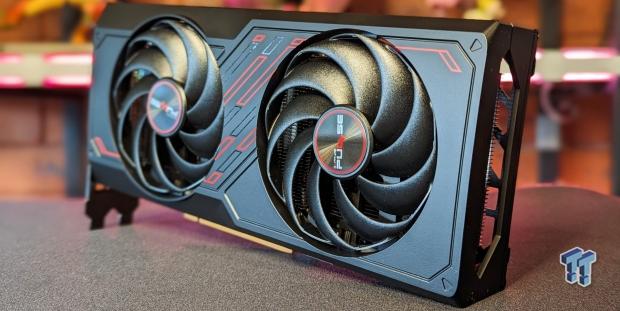
The Bottom Line
Pros
- + A small, compact 1080p GPU
- + Trumps the RTX 3060 in most games we benchmarked
- + The price is right
- + Solid build quality and better cooling than the reference design
Cons
- - Significant performance drop-off at 1440p
- - Ray-tracing performance is a let-down
- - The GeForce RTX 4060 is right around the corner
Should you buy it?
AvoidConsiderShortlistBuyIntroduction
With AMD going the opposite route for its latest RDNA 3 entry by following the flagship Radeon RX 7900 XTX and Radeon RX 7900 XT combo with the new Radeon RX 7600, we tempered our expectations based on a few key factors. First, the price, the MSRP of USD 269, represents a clear play for AMD targeting the mainstream PC gaming market and those that play titles using the popular resolutions of 1080p and 1440p. Though, with all pre-release material and official documentation from AMD positioning the Radeon RX 7600 as a 1080p card first and foremost - that was the angle we took when reviewing the reference model in time for the product's launch.
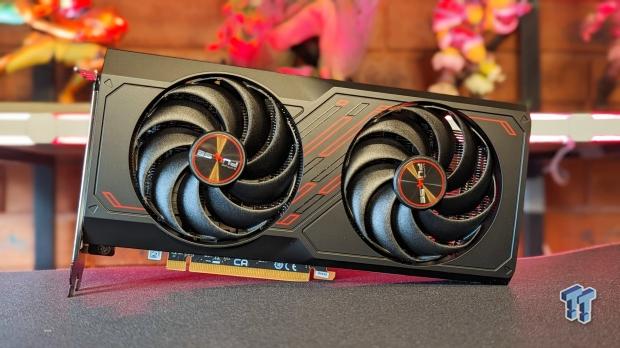
This is not a mid-range offering, so we'll have to wait a little longer before we get to see how the Radeon RX 7600 scales when compared to the still-to-be-announced Radeon RX 7700 XT and Radeon RX 7800 XT. As a mainstream or even entry-level option, the Radeon RX 7600 is more of a GPU you'd consider for a budget build or upgrading from something like the GeForce GTX 1060, RTX 2060, or AMD's own Radeon RX 6600.
According to the latest Steam Hardware Survey results, the 60-class mainstream options from NVIDIA represent some of the most popular GPUs currently in circulation, so there's plenty of room for something like the new Radeon RX 7600. Even when you factor in that older previous-generation cards are presently being sold with a sizable discount, you've got new architecture and features when it comes to something new.
This review covers the Sapphire PULSE Radeon RX 7600 Gaming OC model, which, as we mentioned in our review of the reference card from AMD, is the superior Radeon RX 7600 of the two. Not only in terms of performance, with Sapphire offering some out-of-the-box overclocking compared to the reference specs, but in cooling too. The Sapphire PULSE Radeon RX 7600 runs cooler than AMD's reference model and, in our testing, didn't give off that annoying coil-whine sound we experienced.
It's also a small and compact two-slot GPU, delivering better than GeForce RTX 3060 performance at 1080p, with a lower price point. Let's dig in.

The RDNA 3 Generation
"The world's first chiplet gaming GPU" is how AMD described its new RDNA 3-based GPUs when it lifted the lid on the new Radeon RX 7000 Series. In layperson's terms, the GPU chip isn't just one big square or die anymore, with billions of transistors all arranged in a single layout. Like with its Ryzen CPU range, which embraced chiplet design to great effect (look at how Ryzen has grown in popularity over the years), bringing this design philosophy into the GPU space felt like the natural evolution for AMD's Radeon brand.
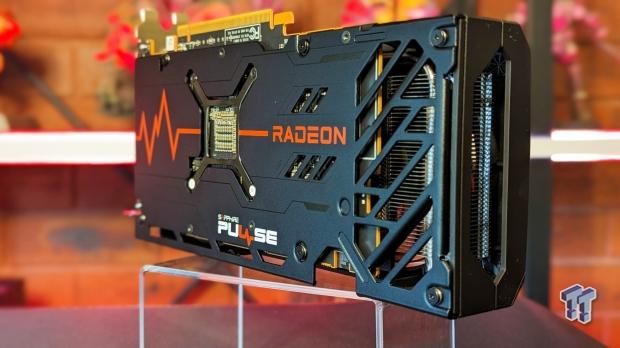
For RDNA 3, what was once a single Graphics Compute Die (GCD) has now split into a GCD plus a Memory Cache Die (MCD). The GCD still makes up most of the hardware grunt and uses the newer 5nm process technology - a step up from RDNA 2's 7nm process. Interestingly, the MCD uses 6nm process technology, which allows AMD to keep costs down as the complexity and cost of manufacturing high-end tech continue to rise.
And to mitigate any performance impact that could arise from going the chiplet route, AMD has also managed to include the "fastest chiplet interconnect in the world," with speeds of 5.3 TB/s. That said, the Radeon RX 7600 and entry-level models using the 'Navi 33' GPU follow a more traditional single-chip setup using 6nm process technology to help keep costs down. But with the same RDNA 3 architecture.
AMD's RDNA 3 architecture features second-generation AMD Infinity Cache, another CPU-like feature designed to boost performance in 1440p and 4K gaming - a "bandwidth amplifier" that sits alongside the GDDR6 memory interface. It helps alleviate the need for more expensive and power-hungry memory buses and is one of those forward-thinking designs we love seeing.
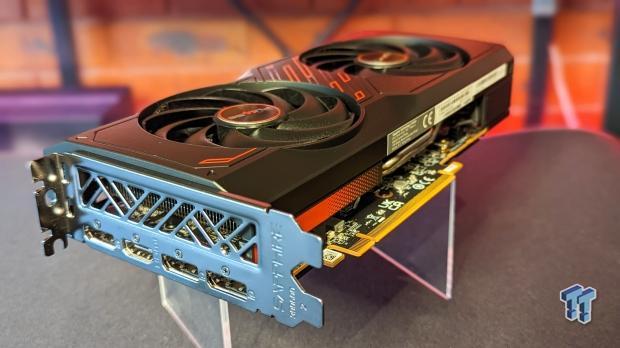
RDNA 3 represents a significant leap forward for AMD regarding ray-tracing and AI accelerators. RDNA 3 GPUs feature the second generation of dedicated RT hardware and new hardware-based AI acceleration. Real-time ray tracing is hardware intensive; this is one area many were looking for AMD to improve compared to RDNA 2. Which, admittedly, was the company's first attempt at hardware-based ray tracing.
RDNA 3 GPUs are the first graphics cards supporting the new DisplayPort 2.1 spec. The latest DisplayPort interface supports up to 4K 480Hz and even 8K 165Hz, which makes it more of a future-proofing measure than something applicable today. But the real benefit comes with 12-bit HDR support and full Rec2020 coverage for improved color accuracy and detail.
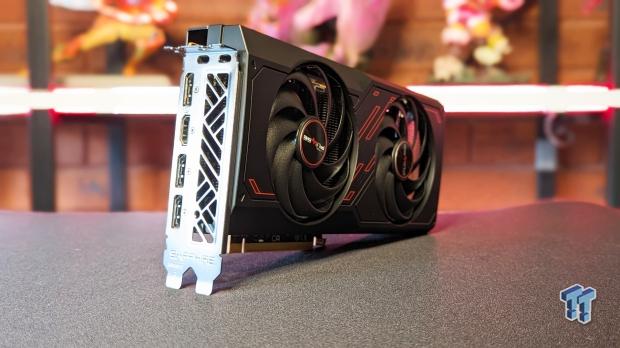
RDNA 3 also introduces hardware-based AV1 encoding to step up its video game for content creators, which means better quality video using the same bitrate. Very cool. For gamers, the introduction of AMD FSR 2 rendering is fully supported here and helps improve performance in intensive games. FSR 2 support might not be as widespread as NVIDIA DLSS, but its addition to games like Cyberpunk 2077 and Star Wars Jedi: Survivor is a great sign. Plus, as the tech is fully supported on Xbox Series X|S and PlayStation 5 (with both consoles using AMD graphics hardware), in-game FSR support should grow as time passes.
AMD has yet to formally showcase or reveal what its DLSS 3-like FSR 3 frame generation technology will look like or whether it will be exclusive to RDNA 3-based hardware, so we'll have to wait and see on that front. Ultimately, RDNA 3 is an impressive leap forward for AMD, bringing massive changes to the underlying hardware while delivering a sizable performance leap over the previous RDNA 2 generation.
Specs and Test System
Specifications
Here we can see how the specs and hardware stack up for the AMD Radeon RX 7600 compared to the previous generation's AMD Radeon RX 6600.
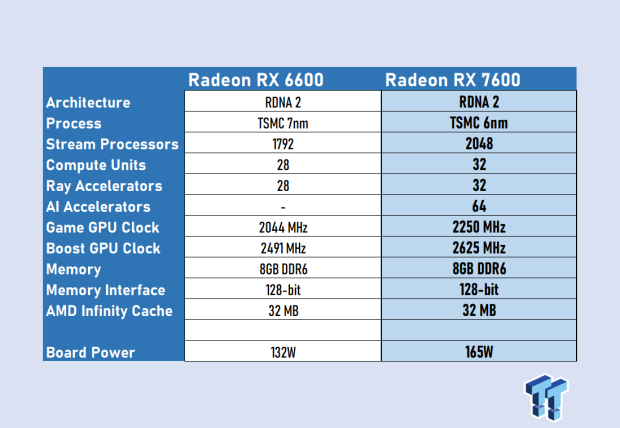
Unlike the flagship Radeon RX 7900 XTX and XT models built using the new multi-chip design, the Radeon RX 7600 follows a more traditional route by using a single and small chip built using 6nm process technology. The reason for AMD choosing 6nm versus 5nm probably comes down to cost, and this is one of the reasons AMD can release the Radeon RX 7600 with pricing starting from USD 269. The lack of the 'XT' branding makes this more of an entry-level GPU, and we wouldn't be surprised if we saw a 7600 XT or 7650 XT in the future.
Compared to the previous generation's Radeon RX 6600, the new Radeon RX 7600 features a 14.3% increase in the Stream Processor and Compute Unit counts - alongside a modest increase in GPU clock speeds. As an OC model, the Sapphire PULSE Radeon RX 7600 features a 2755 MHz Boost Clock and up to 2355 MHz Game Clock, another modest bump over the reference specs above - but a notable increase over the Radeon RX 6600 nonetheless.
Although the current debate around VRAM capacity has put a stigma on any GPU released with 8GB, it still makes sense for entry-level gaming - and even though you're looking at a 128-bit memory bus, there's 32 MB of second-generation AMD Infinity Cache helping to increase the effective memory bandwidth to roughly 476.9 GB/s.
With the move to RDNA 3, the die size for the Radeon RX 7600 has shrunk from 237mm in the Radeon RX 6600 to 204mm here - but even so, the overall power draw of 165W (185W for the Sapphire model reviewed here) is higher than the Radeon RX 6600's 132W.
The bigger power draw is a shame because, like with the high-end cards for the Radeon RX 7000 Series, power efficiency isn't on par with what we've seen from NVIDIA and the GeForce RTX 40 Series. The 165W and 185W are closer to the RTX 4060 Ti and RTX 4070 than the upcoming RTX 4060. RDNA 3's efficiency gains have seemingly fallen short - even for the entry-level Radeon RX 7600.
- GPU: AMD Radeon RX 7600
- Model: Sapphire PULSE Radeon RX 7600 Gaming OC
- Interface: PCI Express 4.0
- Stream Processors: 2048
- Clock Speeds: Up to 2755 MHz (Boost Clock)/Up to 2355 MHz (Game Clock)
- Memory: 8GB GDDR6
- Memory Speed: 18 Gbps
- Memory Interface: 128-bit
- Display Connections: 1 x HDMI 2.1, 3 x DisplayPort 2.1
- Power Connectors: 1 x 8-pin
- Total Board Power: 185W
- What's in the Box: Sapphire PULSE Radeon RX 7600, Quick Installation Guide
Kosta's Test System
- Motherboard: MSI MPG X670E Carbon Wi-Fi
- CPU: AMD Ryzen 9 7900X
- Cooler: Corsair iCUE H100i RGB PRO XT Liquid CPU Cooler
- RAM: 64GB (2x32GB) Corsair DOMINATOR PLATINUM RGB DDR5 DRAM 5200MHz
- SSD: Sabrent Rocket 4 Plus-G M.2 PCIe Gen 4 SSD 4TB, Sabrent Rocket 4 Plus M.2 PCIe Gen 4 SSD 8TB
- Power Supply: Thermaltake Toughpower GF1 850W
- Case: Thermaltake Core P3 Tempered Glass Snow
- OS: Microsoft Windows 11 Pro 64-bit
Physical Design and Cooling
With dimensions of 240 x 107 x 44mm, the Sapphire PULSE Radeon RX 7600 is a small two-slot form-factor GPU that is also reasonably lightweight. It's the sort of card you won't have any issues installing or mounting in any case - including mini-ITX offerings. You're after a no-fuss installation for an entry-level product, and the Sapphire PULSE Radeon RX 7600 delivers on that front.
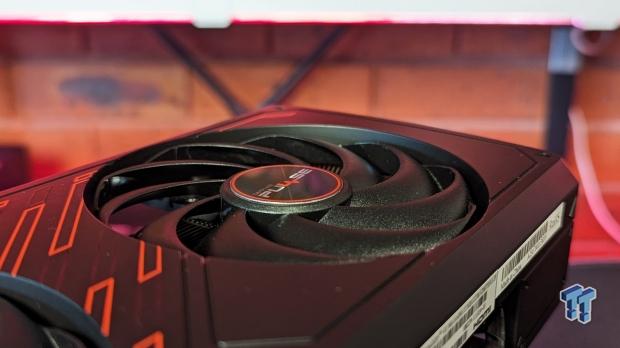
For a new GPU priced at USD 269, you might expect to find adequate cooling alongside build quality that is more serviceable than anything special. The good news is that Sapphire has delivered something pretty impressive with its Radeon RX 7600, where you're getting a robust aluminum backplate, a composite heat pipe system, as well as some very cool nice-to-haves like the dual ball bearing fans and fuse protection on the PCB.
Compared to the sturdy reference design from AMD, Sapphire's take on the Radeon RX 7600 is better executed - especially regarding in-game cooling performance. Although we'll dig into some specific numbers later, the Sapphire PULSE Radeon RX 7600 can run 10 degrees cooler than the reference design, even when under load. And do so with fans spinning at a lower RPM, generating less noise.
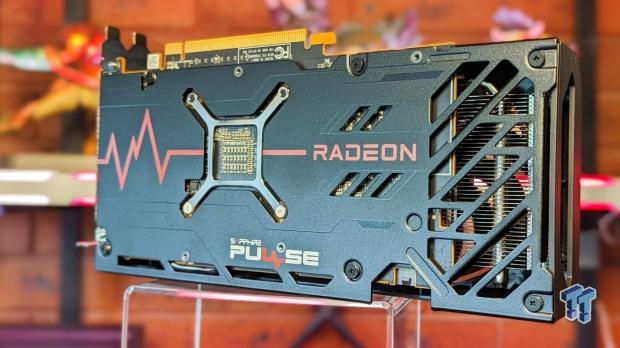
Regarding the physical design, the Sapphire PULSE Radeon RX 7600 follows what we've seen before from the company's Radeon output, albeit in the small and lightweight package that is the Radeon RX 7600. In addition to Sapphire and Pulse branding, you've got Radeon and a classic mix of black and red that combines AMD's overall Radeon aesthetic.
Benchmarks - 14 Game Averages
The Games and Tests
In 2023 PC gaming is a complicated and varied space, from indie games to major blockbuster releases and titles that push hardware and technology to their limit with the adoption of effects like real-time ray-tracing.
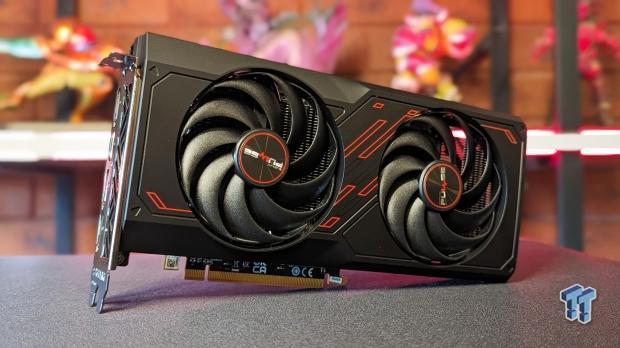
This is all a way of saying that the 14 in-game benchmarks we've chosen (and run at 1080p and 1440p) represent a wide range of styles, not only in terms of genres, like first-person shooters and racing games, but also in the API technology (DirectX 11, 12) and cutting-edge features like ray tracing and upscaling technology.
Results include DLSS and FSR 2, where possible, as both technologies are the sorts of things, especially in 1440p and 4K, which you'd turn on. Six of the 15 game benchmarks also feature ray tracing. Also, each title is set to ultra-equivalent quality settings to push GPU hardware and minimize CPU bottlenecks at higher resolutions.
Also, it's just fun to max out a game's visual settings and see the results. Here's the breakdown of games, graphics settings, and what's being tested.
And with 14 games, a special shoutout goes to Sabrent for providing us with the storage to ensure we can keep everything installed - and then some - with both the Sabrent Rocket 4 Plus-G M.2 PCIe Gen 4 SSD 4TB and Sabrent Rocket 4 Plus Plus-G M.2 PCIe Gen 4 SSD 8TB offering exceptional performance, capacity, and reliability.
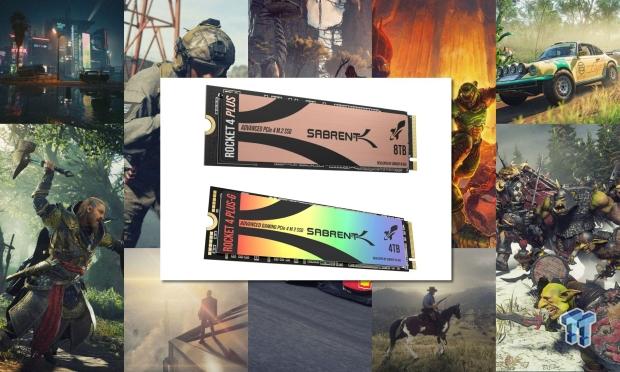
We can keep all our benchmark software installed while also installing every new game release that comes our way.
- Assassin's Creed Valhalla: Ultra High-quality settings, with the in-game benchmark tool used.
- Borderlands 3: Ultra quality settings, with the in-game benchmark tool used.
- Call of Duty: Modern Warfare II: Ultra quality setting, in-game multiplayer benchmark tool used.
- Cyberpunk 2077: Ultra quality setting, in-game benchmark tool used. AMD FSR and NVIDIA DLSS results are included.
- DOOM Eternal (RT): Ultra Nightmare quality setting with ray-tracing enabled, the opening of Mars Core campaign level used to benchmark.
- F1 22 (RT): Ultra High-quality setting with ray tracing, one lap of the Bahrain track benchmarked. AMD FSR and NVIDIA DLSS results are included.
- Forza Horizon 5 (RT): Extreme quality setting with ray tracing enabled, in-game benchmark tool used. AMD FSR and NVIDIA DLSS results are included.
- Hitman (RT): Ultra-quality settings with ray-tracing, Dubai scene benchmarked. AMD FSR and NVIDIA DLSS results are included. A May 2023 update to the game has greatly improved performance, so individual results for this game are excluded for now (but still factored into the averages).
- Horizon Zero Dawn: Ultimate quality setting, in-game benchmark used.
- Marvel's Guardians of the Galaxy (RT): Ultra quality setting with ray tracing enabled, the in-game benchmark tool used.
- Rainbow Six Extraction: Ultra quality settings and in-game benchmark tool used.
- Red Dead Redemption 2: Maximum quality settings, with in-game benchmark tool used. AMD FSR and NVIDIA DLSS results are included.
- The Division 2: Ultra quality settings with in-game benchmark tool used.
- Total War: Warhammer III: Ultra-quality settings with the in-game Battle Benchmark tool used.
14 Game Average FPS - 1080p Results
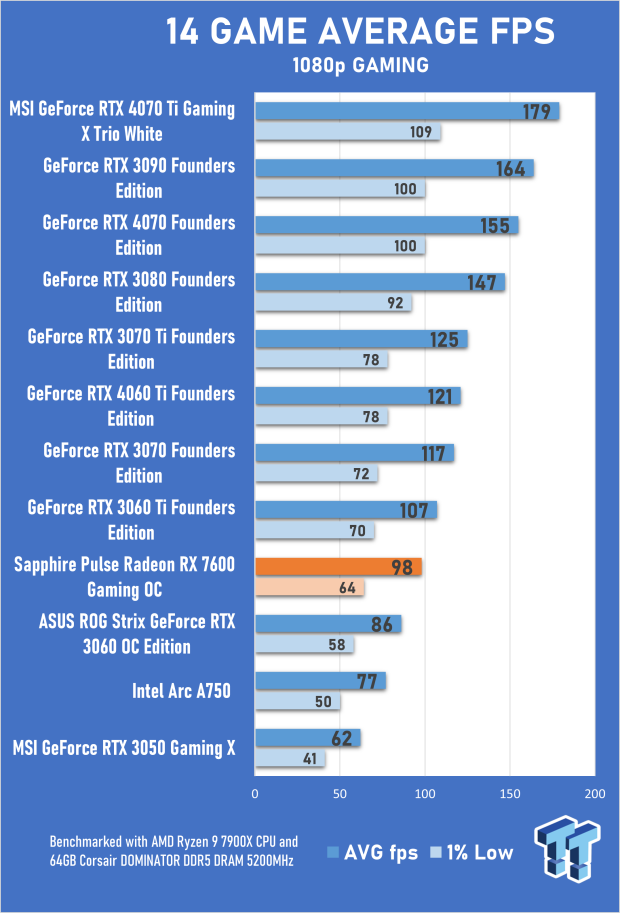
As we didn't have a Radeon RX 6600 on hand for direct-gen-on-gen performance gains, most comparisons from here on out will pit the new AMD GPU against NVIDIA's GeForce RTX 3060. As the GeForce RTX 3060 is currently one of the most popular GPUs in terms of sales and usage, it makes sense, especially when its current pricing is around USD 280 to 300.
Regarding 1080p performance across all games in our testing suite, including those with ray-tracing effects, the Sapphire PULSE Radeon RX 7600 slots between the RTX 3060 and the RTX 3060 Ti. Compared to the GeForce RTX 3060, you're looking at a performance increase of around 13.9% while falling 8.4% short of matching the GeForce RTX 3060 Ti.
Individual results vary from game to game, and the Radeon RX 7600's shortcomings are mostly tied to real-time ray-tracing performance - something that AMD advertises as one of its strong suits. There are some stand-outs. Call of Duty: Modern Warfare II outperforms the GeForce RTX 3060 by a decent margin - 41.2%. Though, for the most part, the results are within that 10% or so range. For those wondering, when stacked against NVIDIA's new GeForce RTX 4060 Ti (which carries an MSRP of USD 399), the Sapphire PULSE Radeon RX 7600 is about 19% slower and 32.6% cheaper.
14 Game Average FPS - 1440p Results
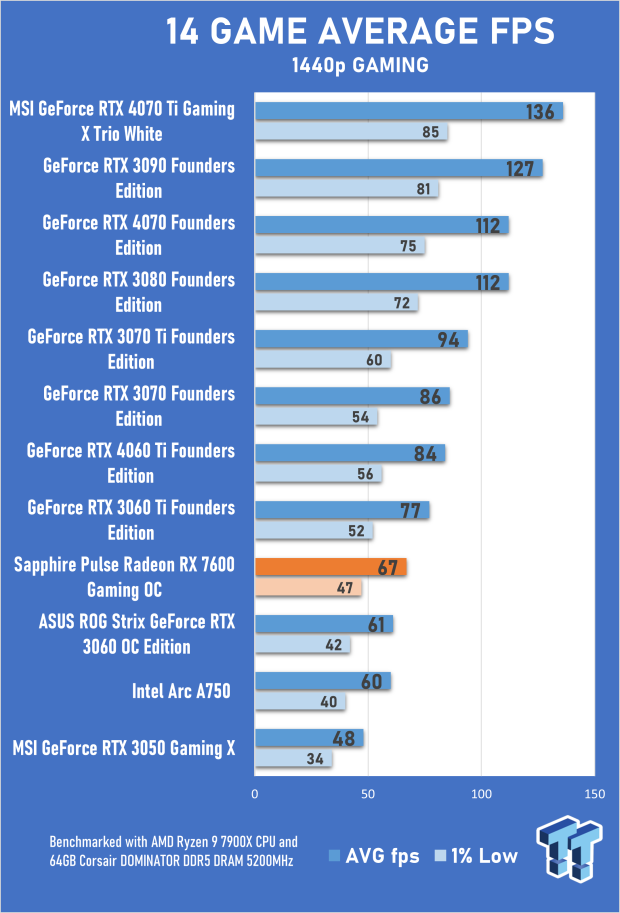
Increasing the resolution to 1440p, which many consider the sweet spot for PC gaming, the drop off in performance compared to 1080p for the Sapphire PULSE Radeon RX 7600 is around 31.6%. It's quite the drop, but with an overall average frame rate of 67 fps, the Sapphire PULSE Radeon RX 7600 is capable of 1440p gaming. However, you might need to tweak visual settings or enable FSR 2 to maintain smooth performance.
Compared to the GeForce RTX 3060 (which does feature 12GB of GDDR6 memory), the performance lead drops to around 9.8%, with the GeForce RTX 3060 Ti gaining momentum at this resolution too. Games like Call of Duty: Modern Warfare II and Borderlands 3 are still the stand-outs for the Radeon RX 7600 here, though ray-tracing performance struggles with results sitting close to or even below the GeForce RTX 3060.
Benchmarks - 3DMark FireStrike
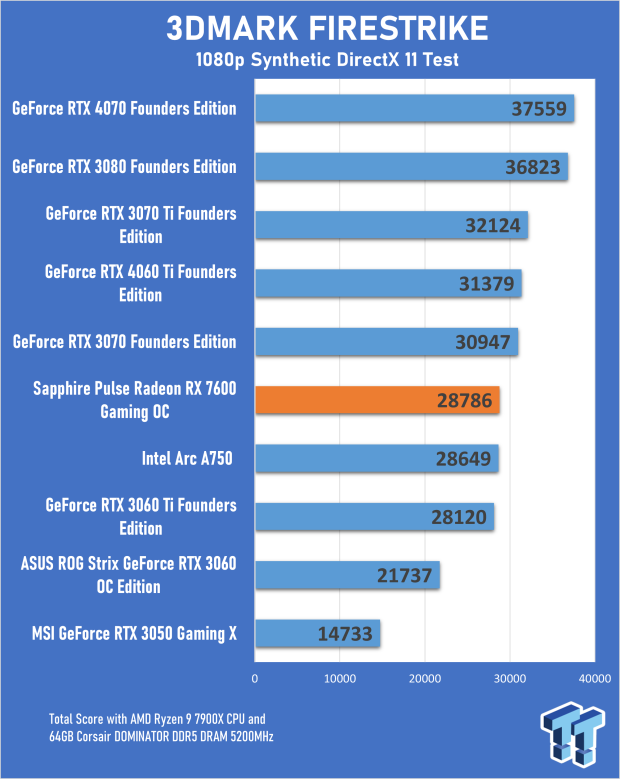
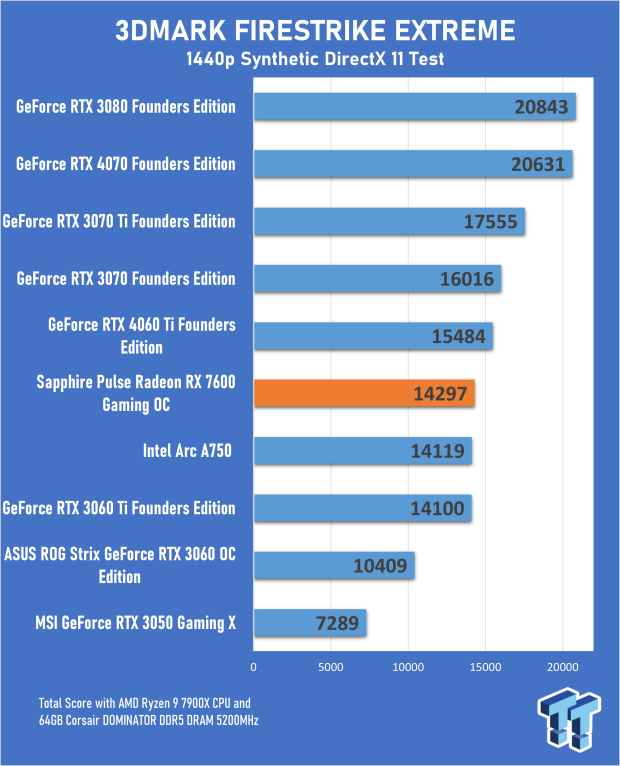
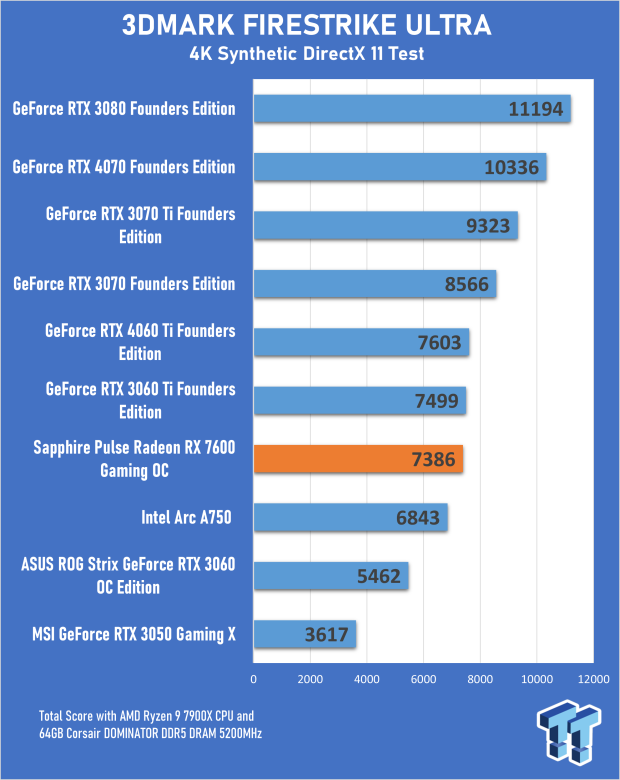
3DMark FireStrike is a DirectX 11 test that has been around for many years and covers quite a large portion of games released over the past decade - at least in terms of the API and graphics technologies used. The three tests cover the resolutions - 1080p, 1440p, and 4K. The 1080p and 1440p tests show that the Sapphire PULSE Radeon RX 7600 slightly edges out the GeForce RTX 3060 Ti while scoring over 30% higher than the baseline GeForce RTX 3060. As a synthetic benchmark, results don't necessarily translate to real-world in-game numbers but could indicate driver-side improvement by AMD in the coming months.
Benchmarks - 3DMark TimeSpy and Port Royal
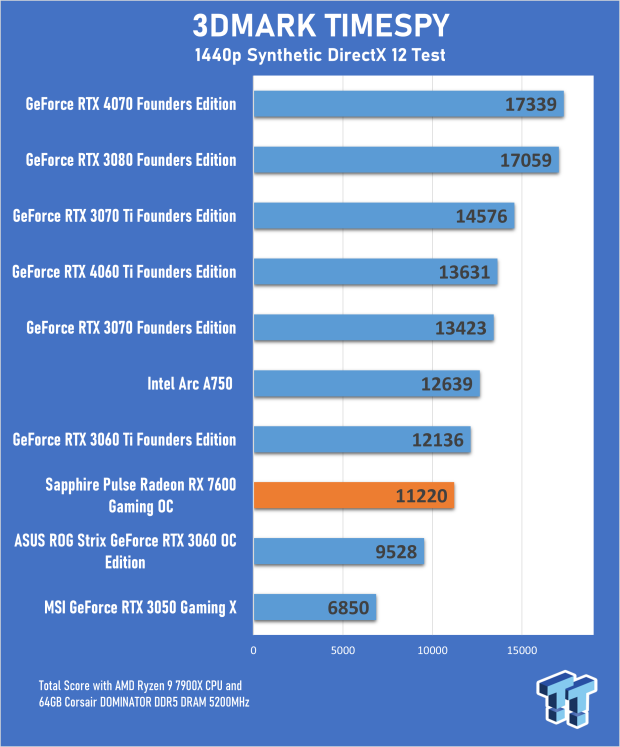
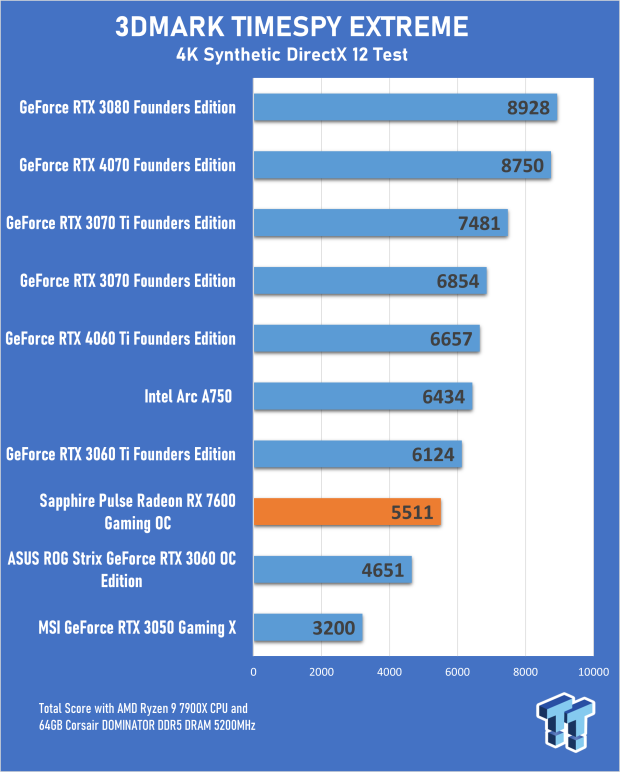
3DMark TimeSpy is DirectX 12-based, so it's a more relevant synthetic benchmark for modern games. Here we see results that more closely match the in-game benchmarks, with the Radeon RX 7600's 1440p score sitting between the RTX 3060 and RTX 3060 Ti. The overall score is 17.7% higher than the GeForce RTX 3060 and 7.5% lower than the GeForce RTX 3060 Ti. It's a similar result for the 4K test. However, the Radeon RX 7600 is not something you'd consider 4K-ready unless you're playing a game with low to medium visual settings.
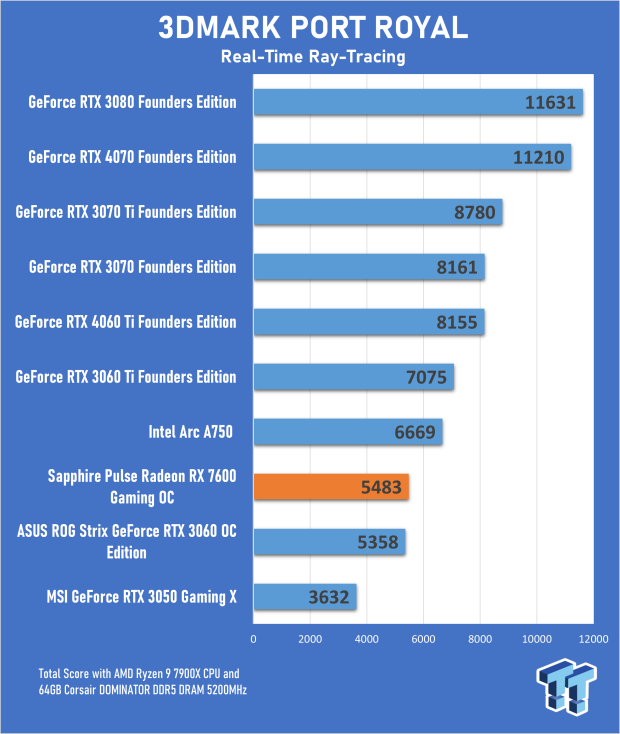
Finally, we have 3DMark Port Royal, a synthetic ray-tracing benchmark. Like turning on ray-tracing in games, the entry-level Sapphire PULSE Radeon RX 7600 delivers a score that matches the GeForce RTX 3060. This means you can expect a pretty sizable drop in performance when enabling the hardware-intensive effect, so it's probably not worth it in many cases. Looking at DOOM Eternal (and its Vulkan API favors RTX hardware), with RT effects enabled, performance on the Radeon RX 7600 takes a massive hit at 1080p and 1440p.
The same happens with Marvel's Guardians of the Galaxy and Cyberpunk 2077. However, ray tracing performance in games like Forza Horizon 5 and F1 22 beats the GeForce RTX 3060 - which is excellent. And both of those titles support AMD's FSR 2.
Benchmarks - 1080p Gaming
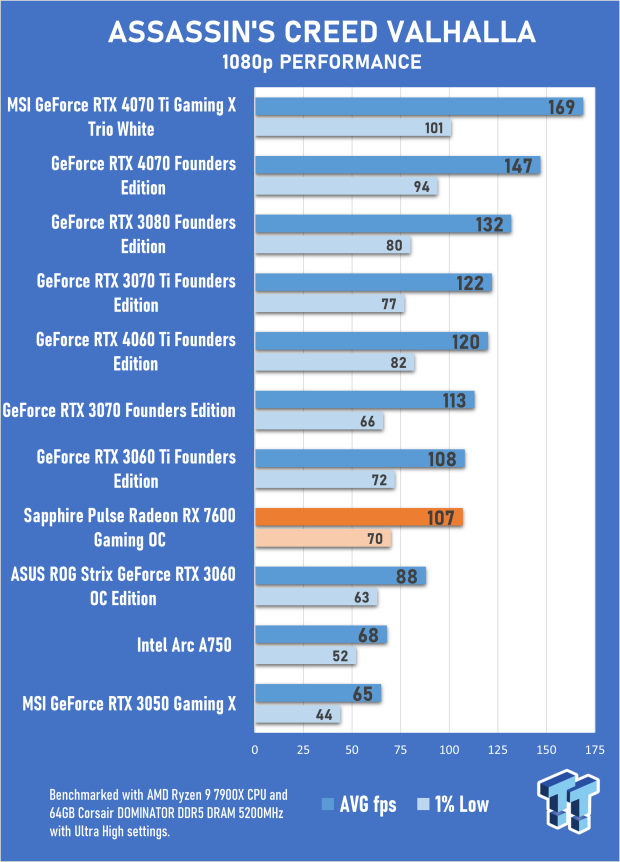
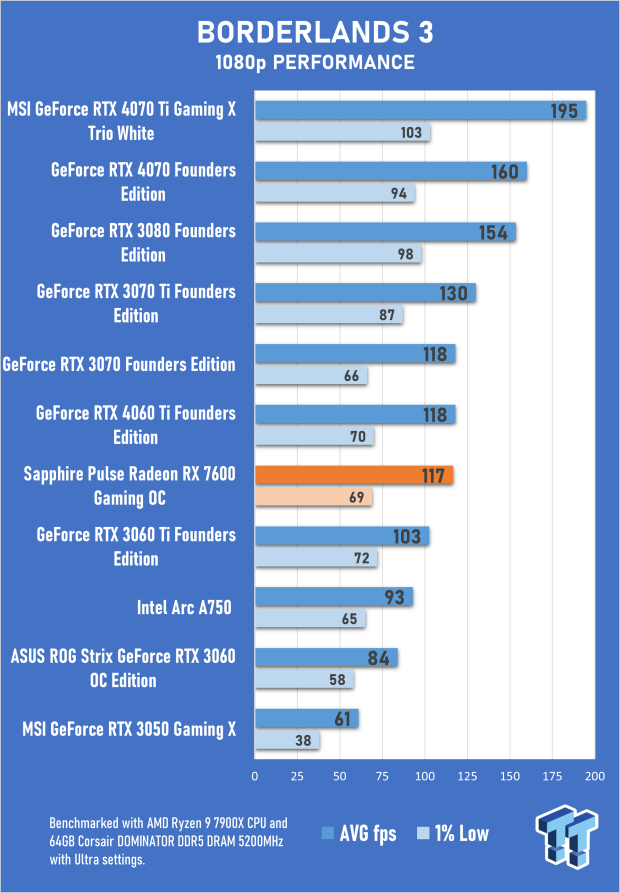
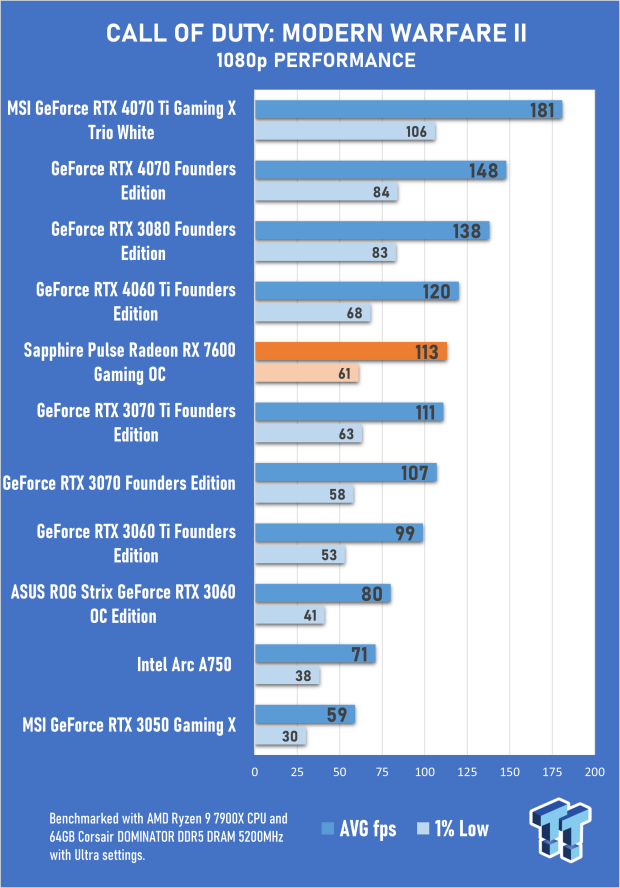
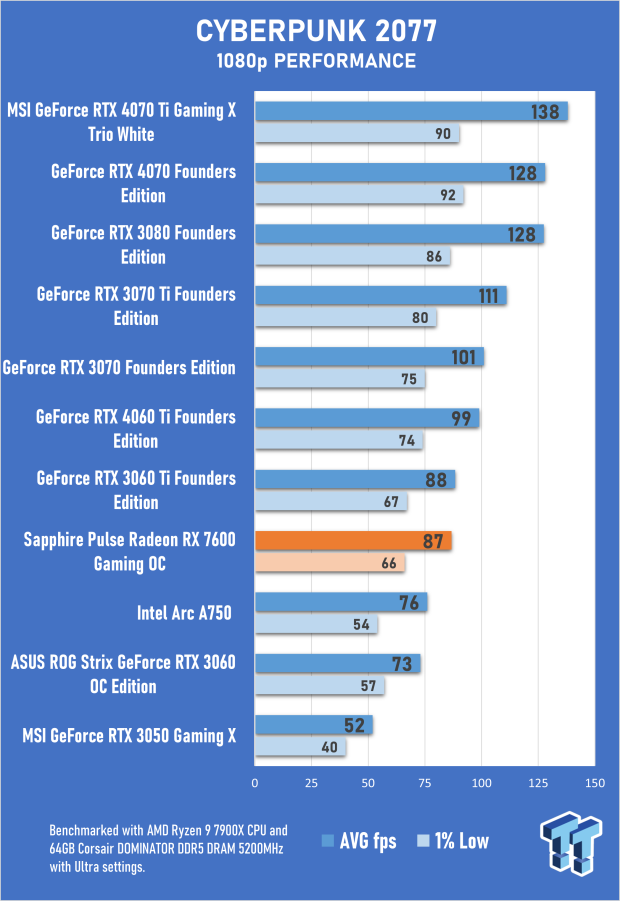
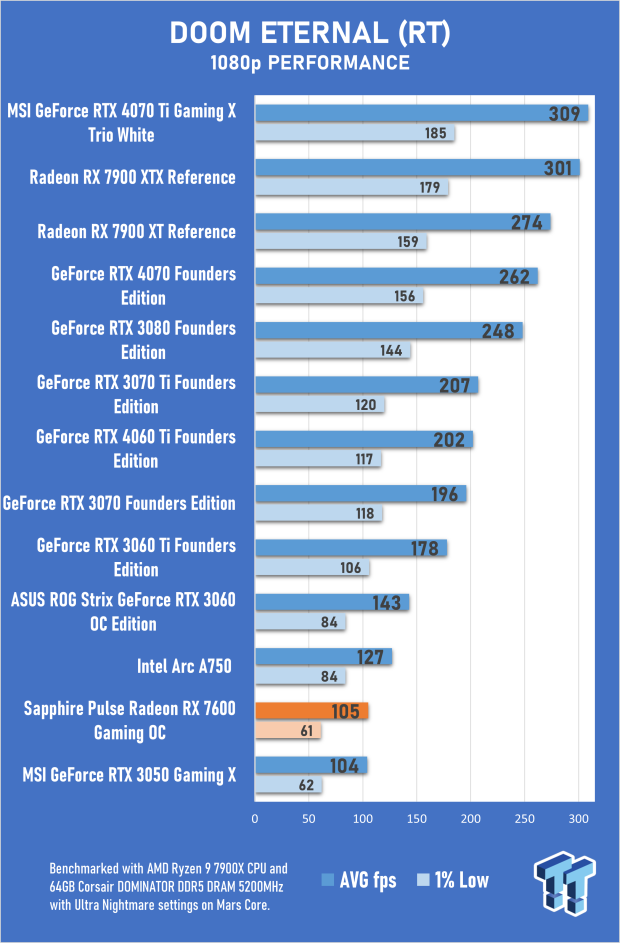
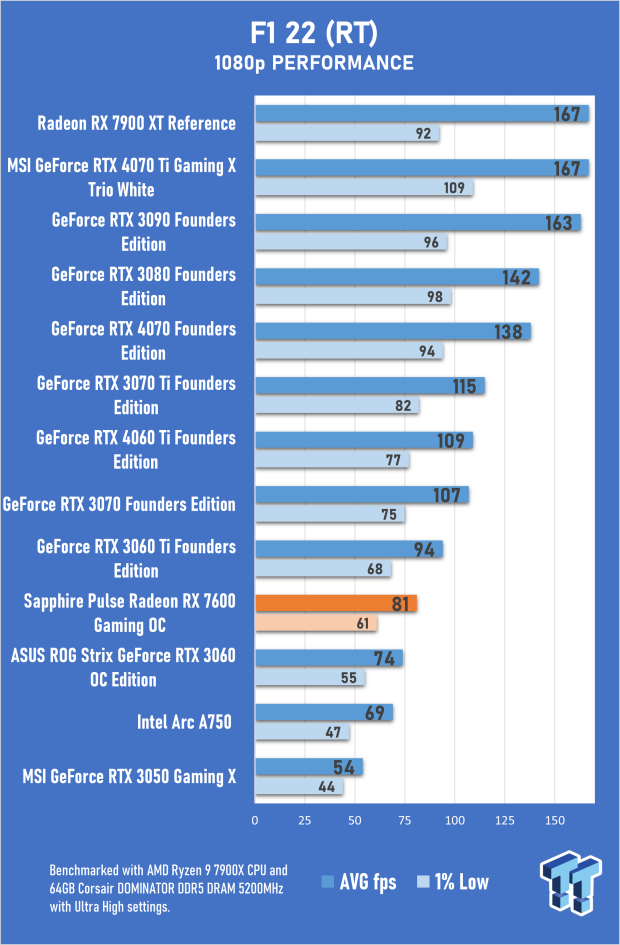
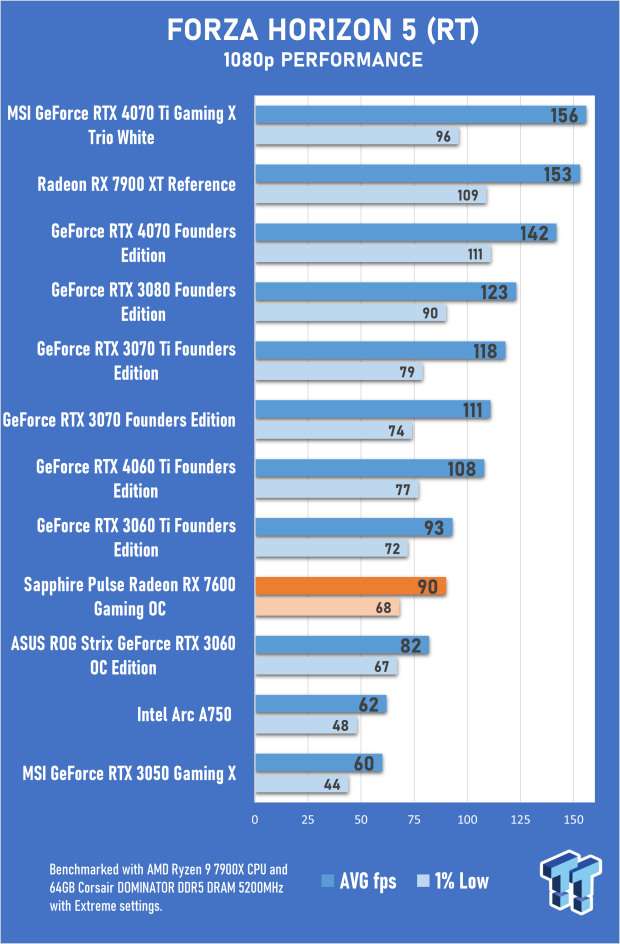
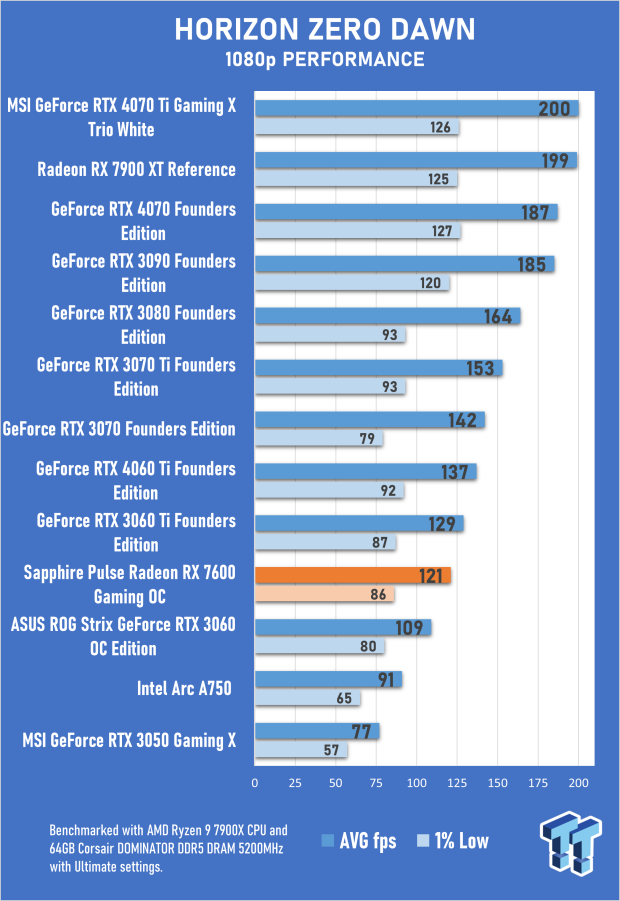
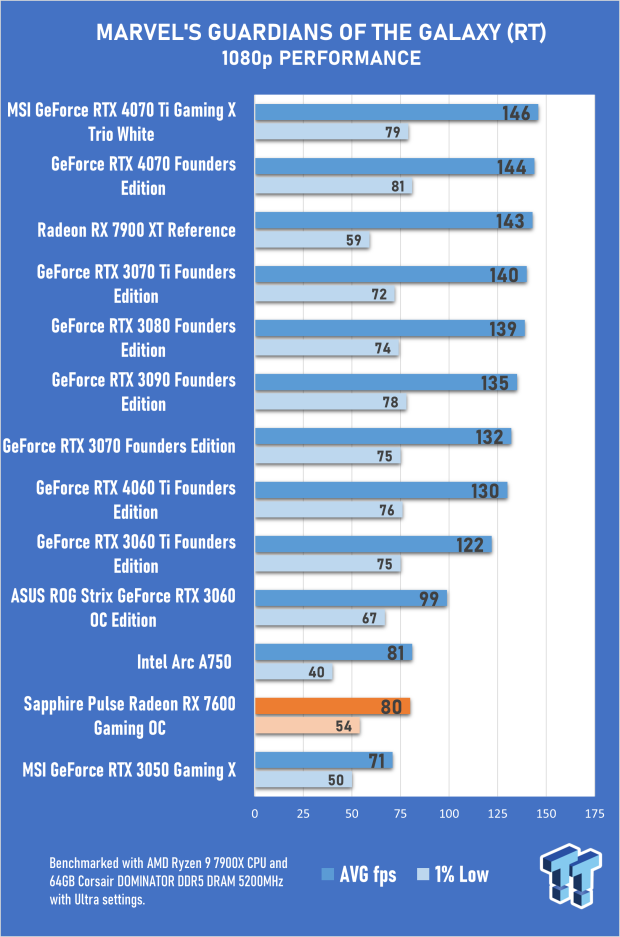
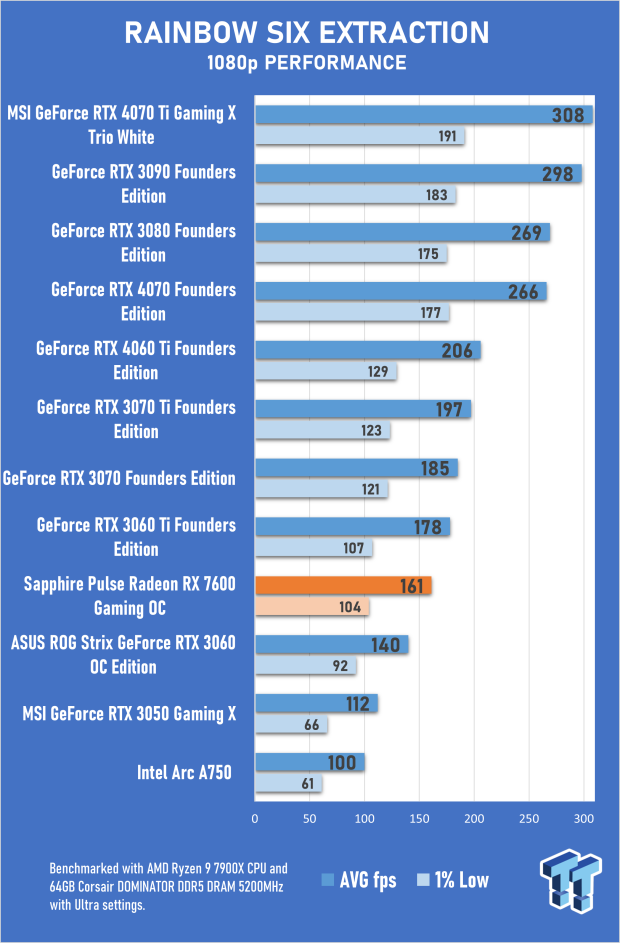
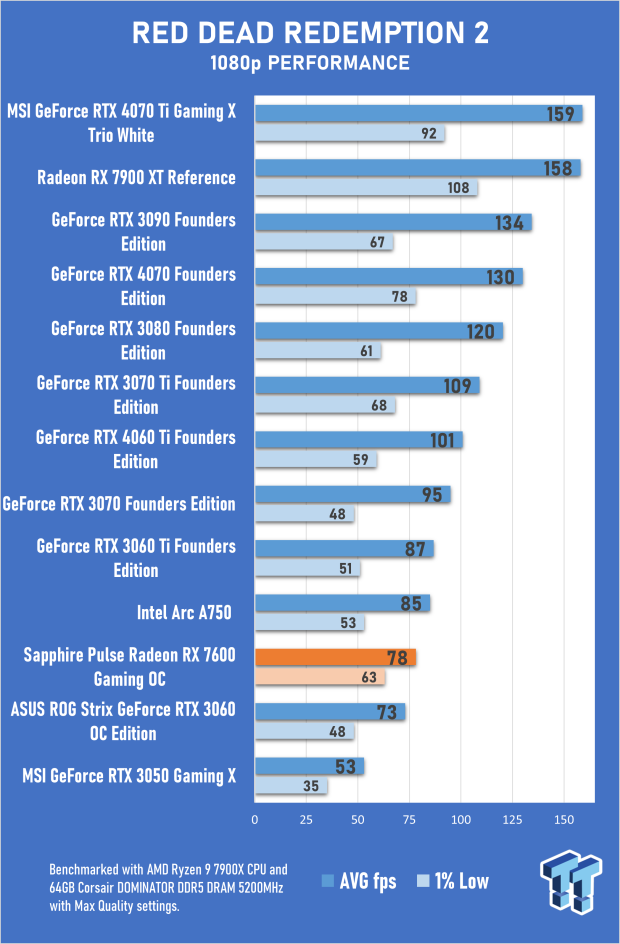
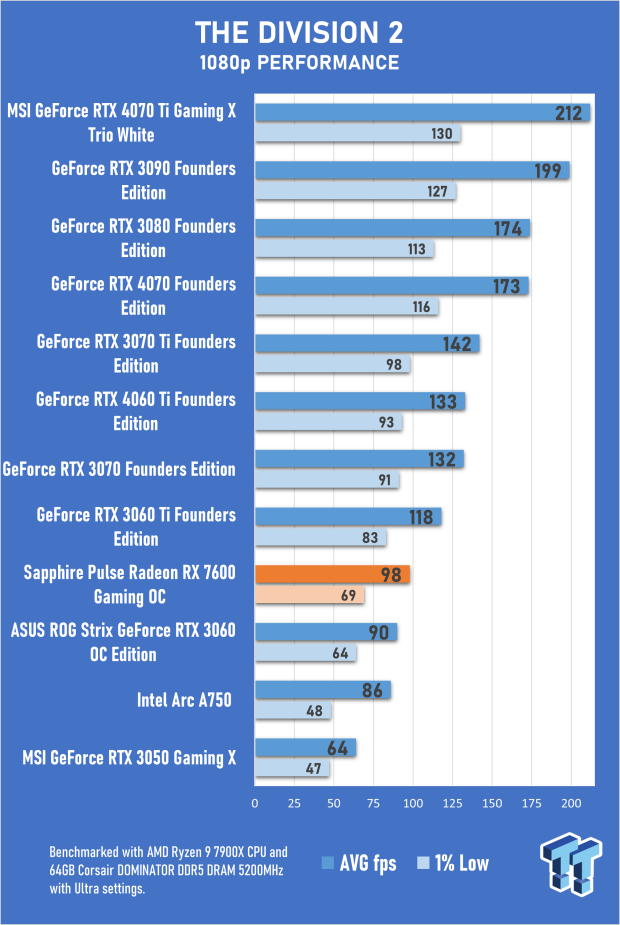
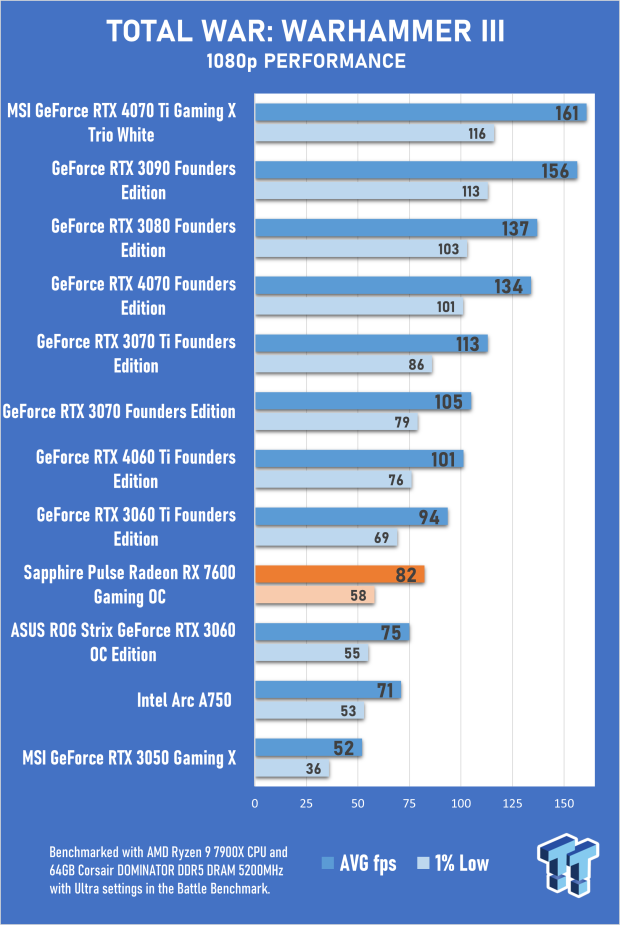
Benchmarks - 1440p Gaming
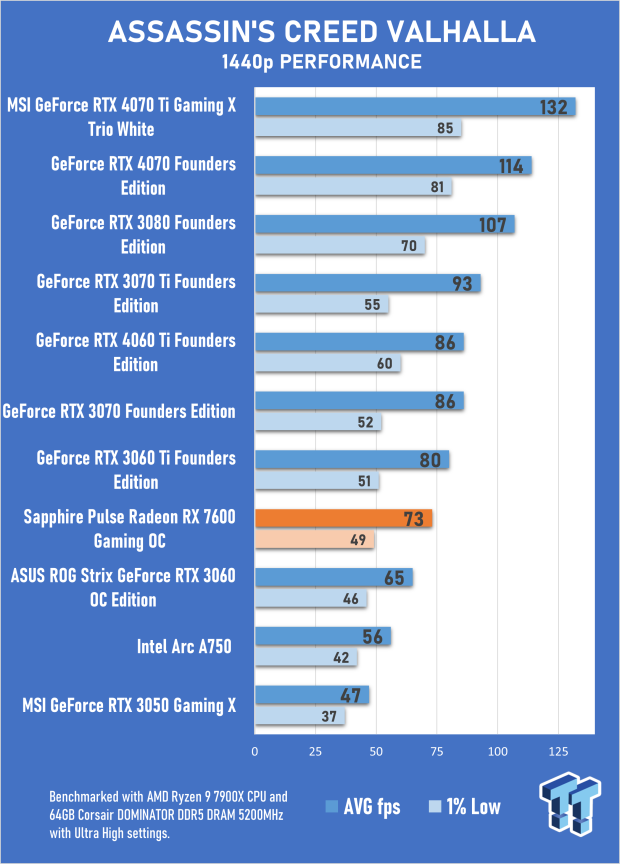
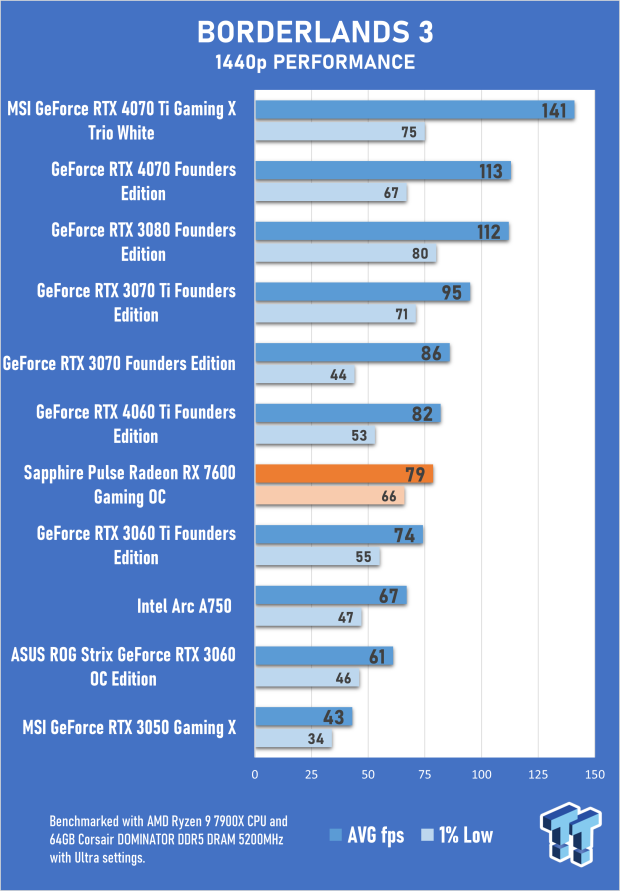
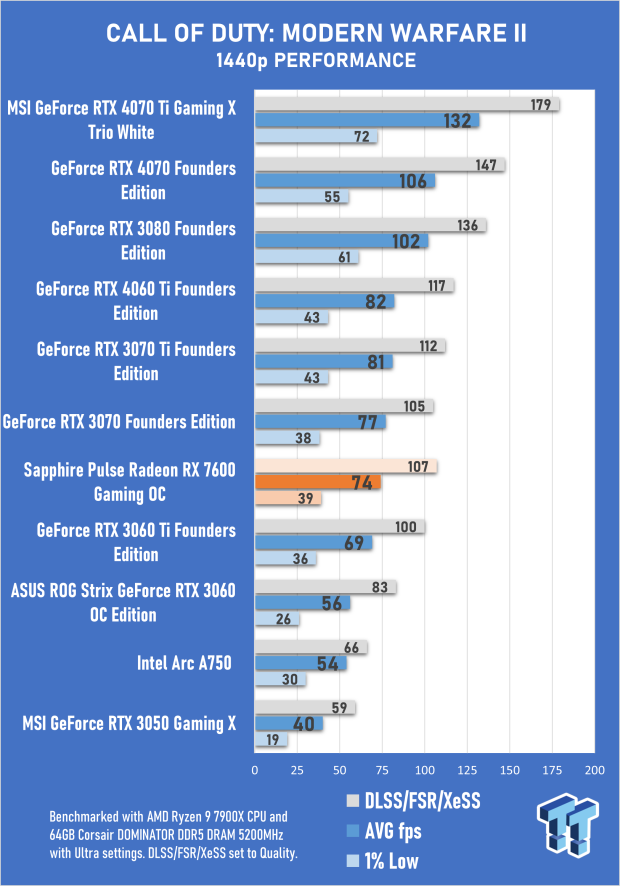
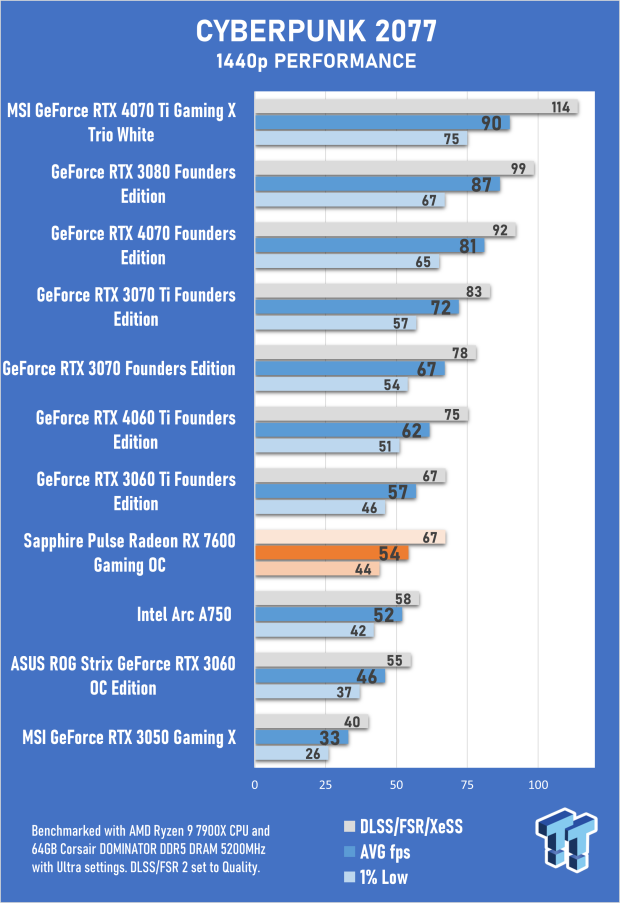
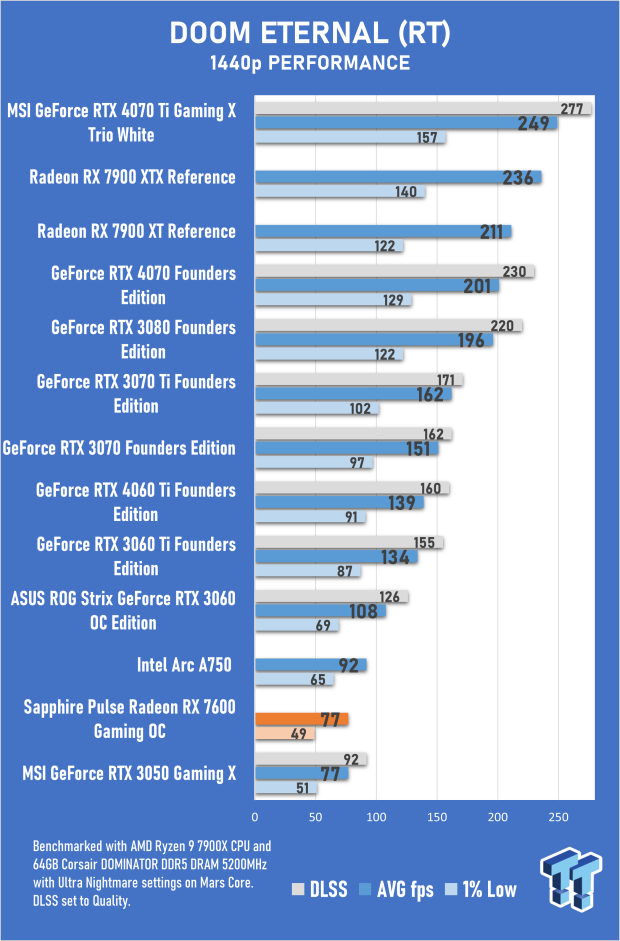
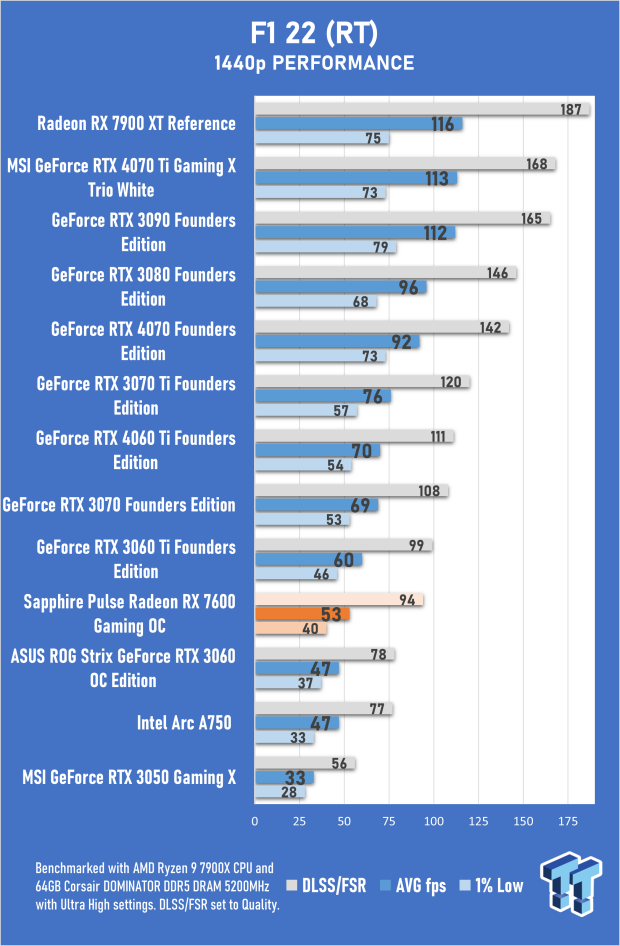
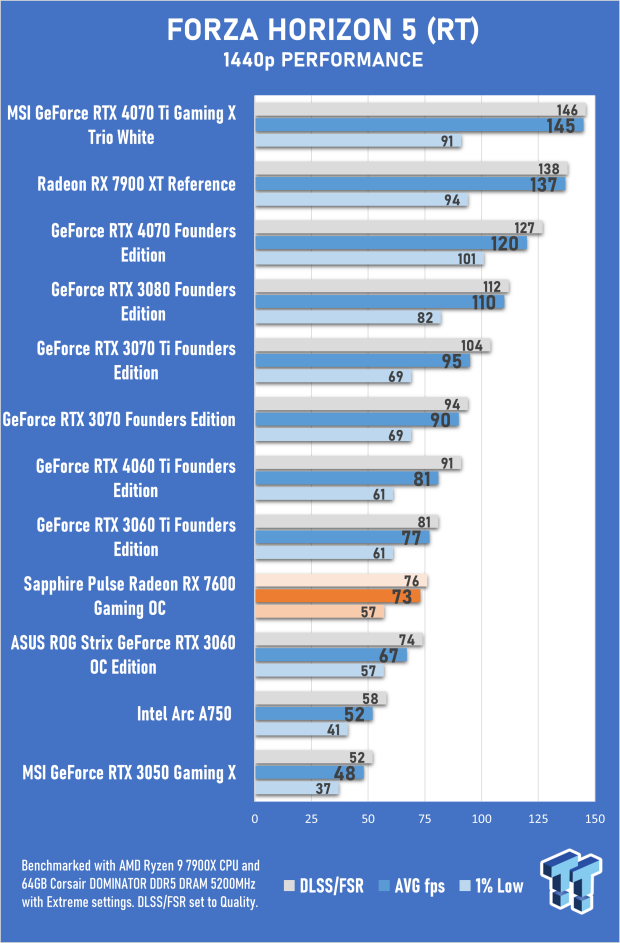
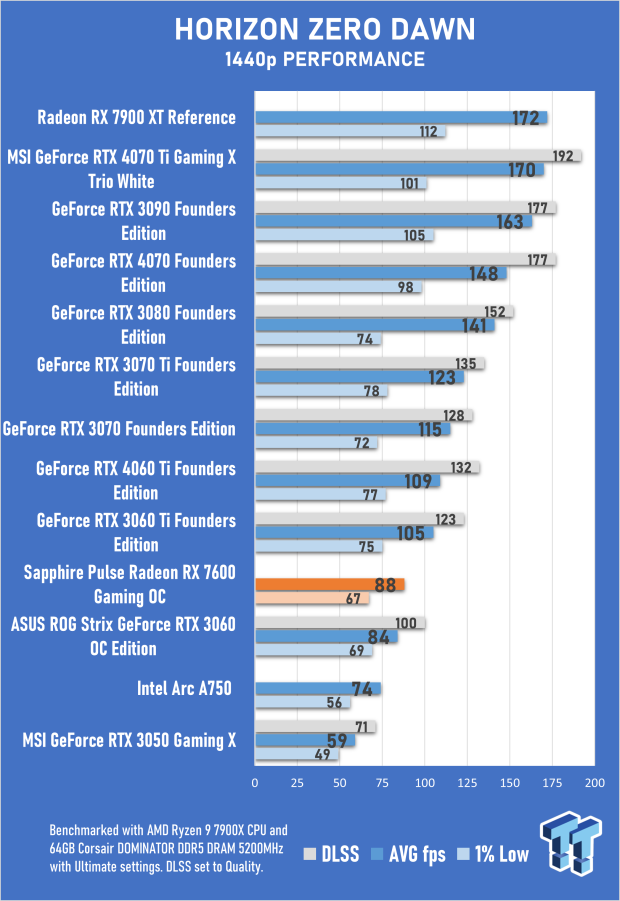
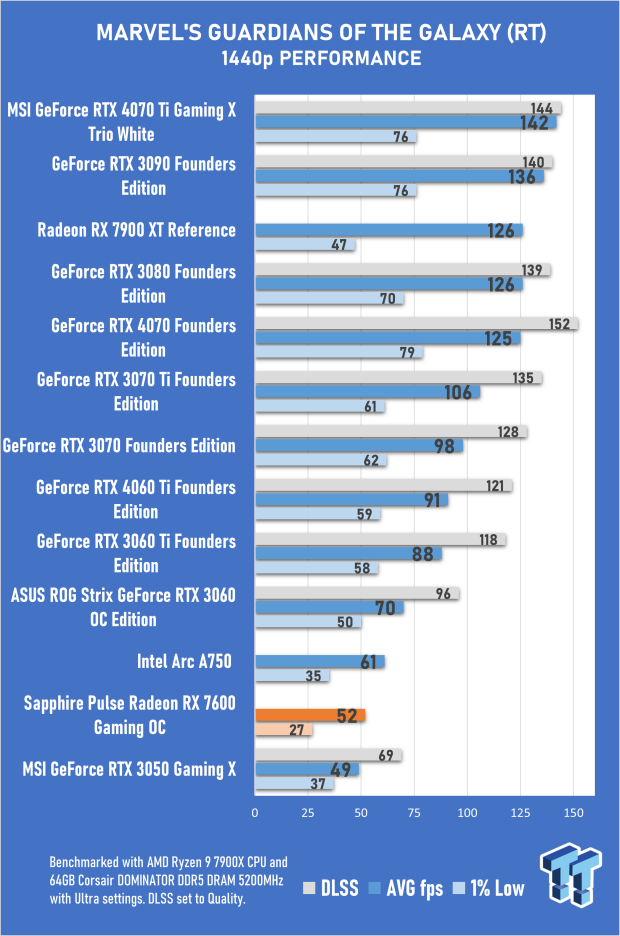
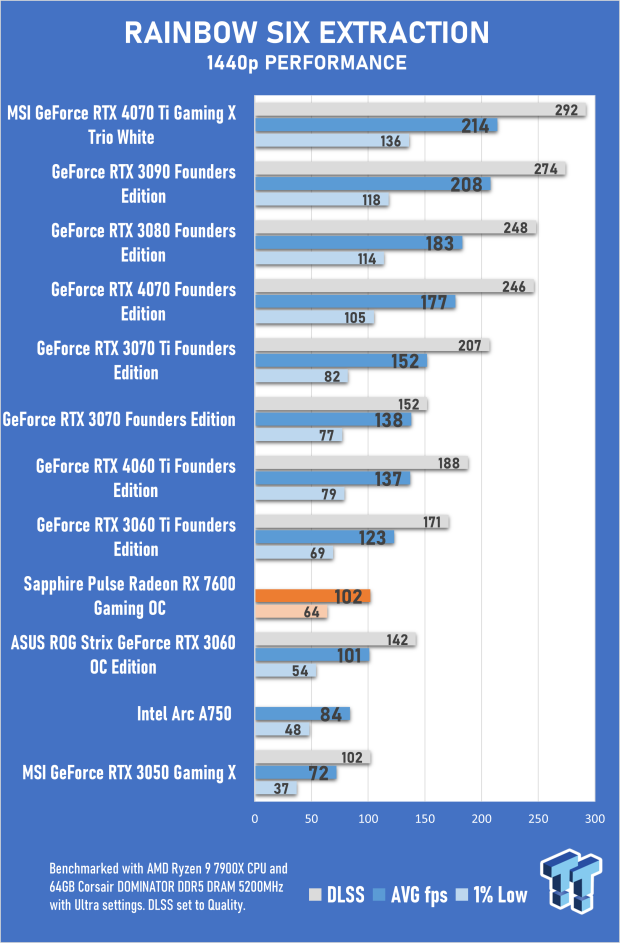
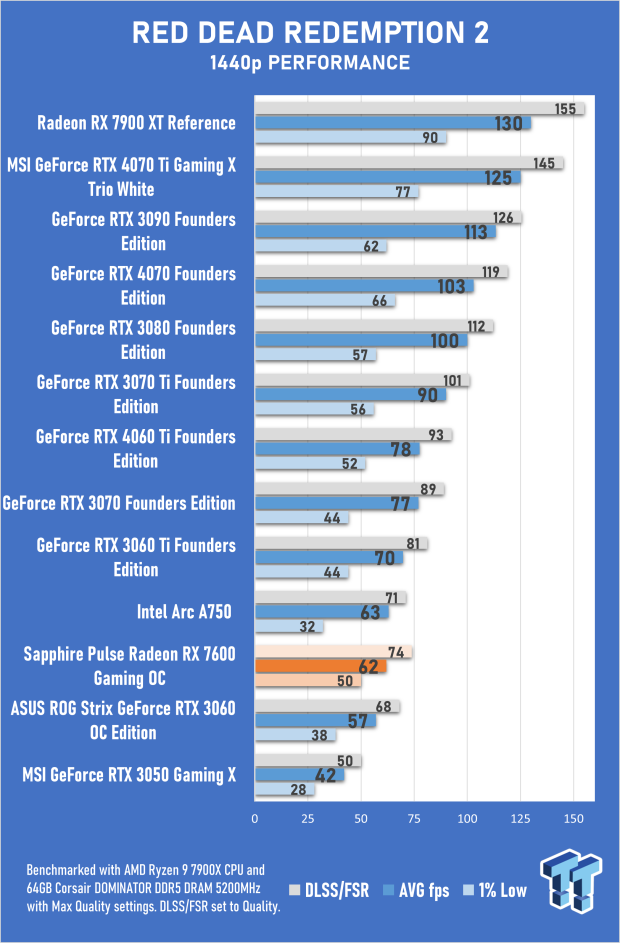
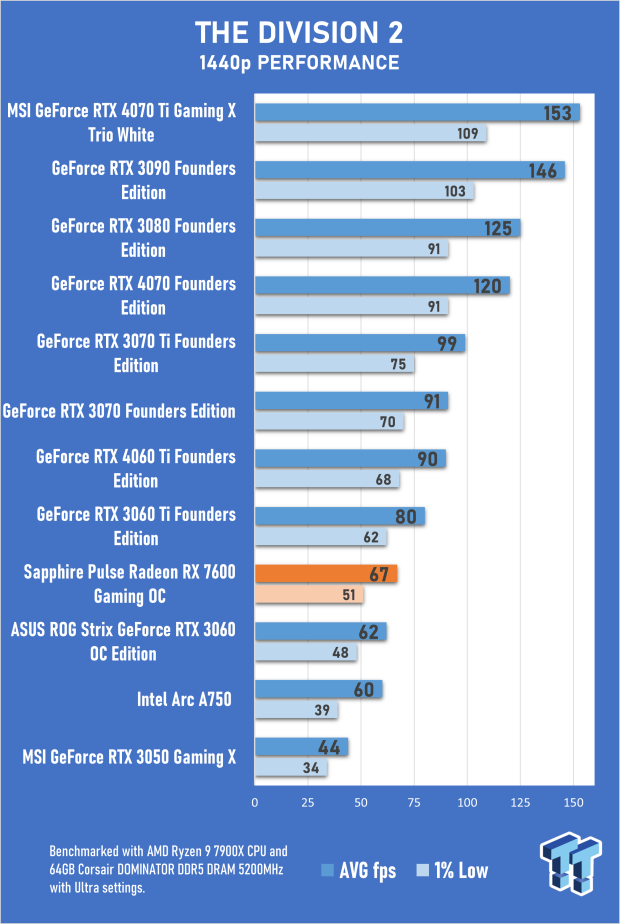
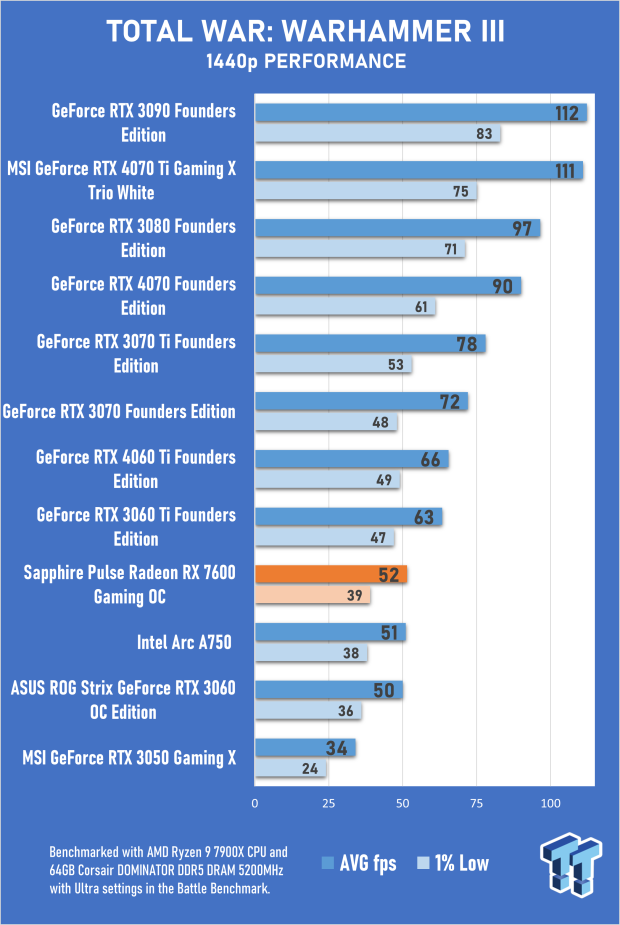
Benchmarks Summary, Ray-Tracing Performance, and FSR 2
As per the averages, the Sapphire PULSE Radeon RX 7600 is a card best suited to 1080p gaming, where it can deliver impressive results even with all visual settings cranked up. At 1080p, VRAM limitations are less of an issue, too, so the 8GB isn't a bottleneck for most titles when played at this resolution. For the most part, the performance sits between the GeForce RTX 3060 and the RTX 3060 Ti, with the Radeon RX 7600 doing so with a lower price point (as of writing) than these NVIDIA options.
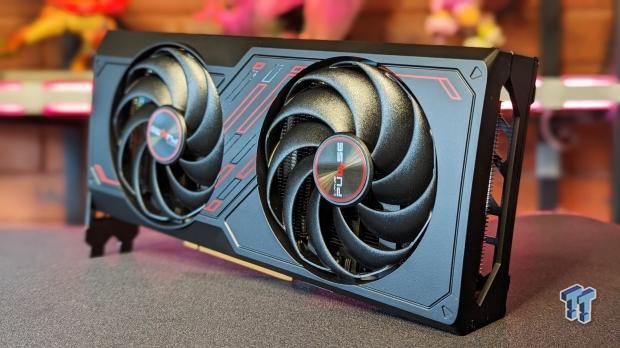
Ray-tracing is where the Radeon RX 7600 tends to fall apart - so to speak - though it is capable in this department when RT is limited to a single effect, like shadows or reflections. The other big downside is the performance drop-off when you bump up the resolution to 1440p, over 30%. The good news is that AMD's FSR 2 mitigates this, but it's an upscaling technology that looks inferior to NVIDIA's DLSS when enabled at 1440p. Plus, it's not as widely adopted.
But the image quality when using the FSR 2 'Quality' preset is decent and worth enabling when you can push Call of Duty: Modern Warfare II's 1440p performance to 107 fps from 74 fps and F1 22's up to 94 fps from 53 fps. The other good news comes from the implementation of AMD's Infinity Cache, which sees overall 1% low performance being pretty impressive - especially when you compare it to the GeForce RTX 3060, which features 50% more VRAM than the Radeon RX 7600.
Temperature and Power Efficiency
The Sapphire PULSE Radeon RX 7600 drew around 181W of power during our stress test, which isn't great. At least compared to the previous generation Radeon RX 6600's 132W power rating and what we've seen with NVIDIA's new Lovelace graphics cards. For example, the more powerful GeForce RTX 4060 Ti in the same test only drew 125W - so the power efficiency in correlation to performance is a step behind the competition. You're still looking at a single 8-pin power connector and a small form factor, which is a plus.
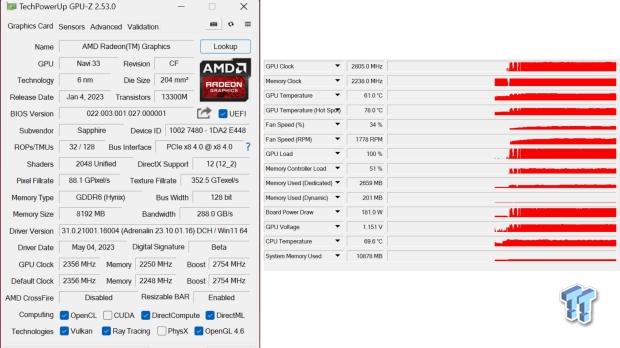
The Sapphire PULSE Radeon RX 7600 is more impressive than AMD's reference model as it maintains lower temperatures (with the same hotspot temps) with lower fan speeds. Where the reference design might push fan speeds to over 50% and temperatures to around 70 degrees Celsius the Sapphire PULSE Radeon RX 7600 will keep the temperature closer to 60 degrees Celsius with fan speeds of about 30-35%. Even though that does mean higher RPMs, the overall noise level is lower.
Final Thoughts
The budget GPU space is competitive, with massive discounts on previous-generation cards. Then there's Intel continuously lowering the price for the Arc A750 and NVIDIA prepping to release the baseline GeForce RTX 4060 at the end of the month with a price point of USD 299, which was going to be the price for the Radeon RX 7600 until we got word that it had been dropped to USD 269 days before the card's release.

Even though the Sapphire PULSE Radeon RX 7600 is a far better option than AMD's reference design for the Radeon RX 7600, it's still not all that exciting outside of being an affordable alternative to the GeForce RTX 3060 that improves on that card's performance, albeit in a way that isn't earth-shattering, not to mention the fact that you've got a real-time ray-tracing performance that still feels a step or two behind the competition.
Still, if you're putting together a budget 1080p gaming rig, the Sapphire PULSE Radeon RX 7600 presents excellent value.

